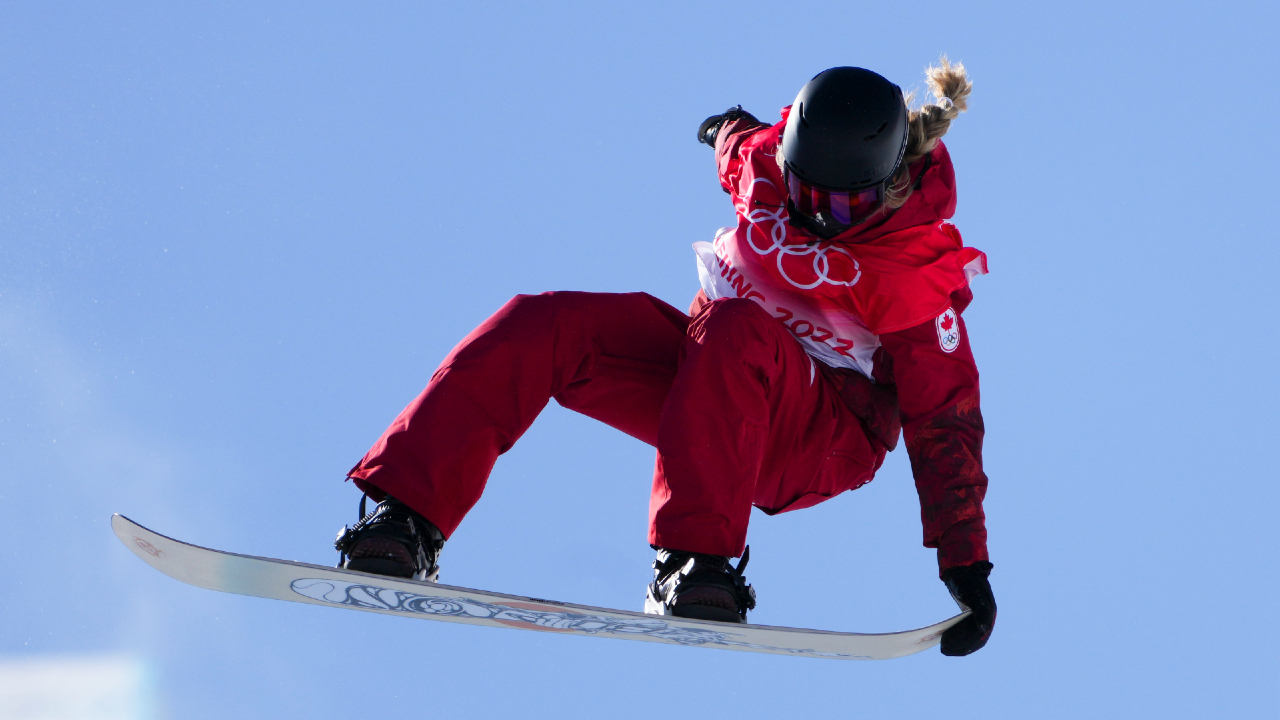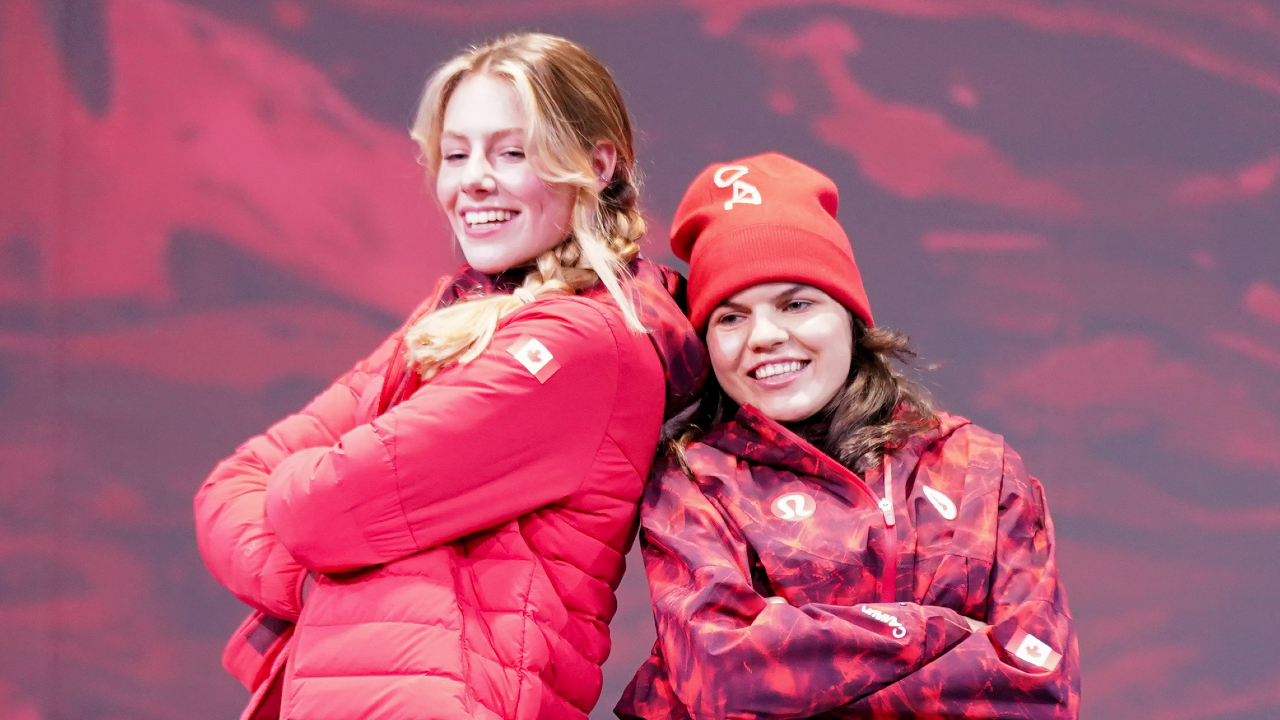
After the most hectic year of her young career — one with unending testing, a broken wrist that followed a broken humerus, and the general chaos of navigating life as an Olympic hopeful while uncertainty looms above like a storm on the mountain — the manner in which Brooke D’Hondt found out her dreams came true was surprisingly low-key.
“I kind of just got an email about it,” she says with a laugh. Mellow as the delivery method might’ve been, the news relayed to her inbox in that particular message was life-altering — it informed D’Hondt she had qualified for the 2022 Winter Olympics, granting her a path to the biggest stage of her career thus far. In getting there, D’Hondt earned the unique distinction of being Canada’s youngest Olympian at the 2022 Games, the Calgarian snowboarder set to take on the half-pipe in Beijing at just 16 years old.
But while the opportunity to compete against the world’s best comes early in D’Hondt’s career, the pandemic’s made her earn it all the same.
“I’ve been working towards this goal for the past year, so it was really cool and I was super excited to see it kind of all come together,” she says. “It’s definitely been a crazy year with hundreds of COVID tests and getting the Swiss passports and visas to travel to different countries. But I’ve had a great support staff helping me, so it hasn’t made the snowboarding too difficult.
“I’ve just been working as hard as I can to prepare this last year — mentally, physically, in the gym, and taking advantage of every day on snow.”
D’Hondt’s been on snow almost as long as she’s been anywhere. Growing up in Calgary, a couple hours from Lake Louise, Alta., she started skiing with her family in the mountains at two years old. Three years later, her parents gifted her a snowboard for Christmas, and a five-year-old D’Hondt found her true calling. “I kind of just fell in love with it then,” she says.
She never looked back. It was only four years after that switch that D’Hondt started competing, beginning with race events, slopestyle and half-pipe. By 13, she was winning national events, rising through the ranks as one of the snowboarding world’s most promising talents.
Excelling in the half-pipe at such a young age isn’t exactly a common story in Canadian snowboarding, says her coach Michael Slaughter, who also serves as the Canadian national team’s half-pipe coach. Key to the equation for D’Hondt was the presence of Winsport’s Canada Olympic Park, a training facility in Calgary originally transformed from a local ski hill into a world-class site for Canadian winter athletes ahead of the 1988 Olympic Games — and sitting just 10 minutes from where D’Hondt grew up.
For her, C.O.P. was akin to a wintery playground, allowing her to experiment with different aspects of the snowboarding world. It was there that she began honing her skill in the half-pipe. And it was in that same pipe — which also serves as the one used by Canada’s national team — that Slaughter first began working with D’Hondt. It didn’t take long for him to see her potential, and for the pair to see results.
“We started off just going through more of the ‘B’ realm of contests in the world,” he says. “We went for the Revolution Tour and she won the whole thing, and at the end of the year, won the overall. And then also in that same year, she won the Junior Jam.”

Snowboarders Brooke D’Hondt, left, and Sandrine Hamel at the Team Canada x Lululemon Athlete Kit Reveal in Toronto. (Evan Buhler/CP)
The standout 2019 led D’Hondt to her first taste of the wider spotlight in early 2020, when she earned a shot to go to the Winter X Games in Aspen as an alternate for the Women’s SuperPipe. But an injury to former Olympian Arielle Gold threw a plot twist into the mix.
“The night of the competition, I found out I was going to be competing and I had a spot,” D’Hondt says. “So, kind of a bit of a mental adjustment, but I was super grateful for the opportunity.” She wound up finishing sixth, but having climbed up to a new level in the sport, she kept pushing forward, competing in the 2020 Dew Tour, reaching the semi-finals in the 2020 Burton U.S. Open, and getting back to the X Games in 2021.
Ultimately, she put up impressive enough performances in her four events leading up to the 2022 Games to earn the title of Olympian just seven years after her very first competition as a nine-year-old back in Calgary. Slaughter isn’t surprised.
“She just has a good belief in herself, of wanting to be one of the top five women snowboarders right now. I think that’s the goal she’s living off of,” he says. “It’s super hard to be there, but, you know, she’s trying — she’s taking the licks and putting the time in.”
A former professional snowboarder out of Vermont himself back in the ‘90s, and a coach for plenty an Olympian — from Americans Steve Fisher and JJ Thomas to current Canadian standout Derek Livingston — Slaughter’s seen first-hand what it takes to get to the next level, and to thrive upon arrival.
If there’s one key aspect of D’Hondt’s rise for him, he says, it’s how effortless she’s made the difficult ascent look so far.
“Coming up from a club program to a national team program perspective is always a huge transition for an athlete,” he explains. “She handled that process really well, and it was kind of refreshing in the sense of just having an athlete be able to go out and land runs and do well. That’s kind of been her roadmap.”
D’Hondt’s plowed ahead on that road even as the pandemic’s dropped more and more obstacles in her way during the most important years of her young career. Even as a broken humerus in the summer of 2020 sidelined her until the Fall — requiring surgery to insert six screws and a plate in her arm — and a broken wrist in 2021 added another obstacle to that path.
Now, after all of it, the lights will fall brighter than ever on D’Hondt as she prepares to compete on the most grand stage there is, taking the half-pipe for her first event on Wednesday morning in Beijing under those hallowed Olympic rings. For the 16-year-old phenom, it’s the unique aura of the Games that’s cause for the most excitement ahead of her first run.
“I think just taking in the village, and Team Canada all dressed the same, and competing under the same flag with different athletes in different sports — I’m super excited to be competing with all my friends on the biggest stage,” she says.
As for the snowboarding, the goal is to try to make it through without heaping too much expectation on herself, she says. But advice from pals and mentors who’ve competed under those rings before has made clear the weight of the moment.
“All they say mostly is, ‘There’s nothing like the Olympics.’ You can try to make it something smaller, just like a World Cup, but there really is nothing like it,” D’Hondt says. “It’s definitely going to be more nervous standing up at the top, but I think [it’s knowing] you compete with these people at every competition, so try not to make it too big of a deal in your head.”
Her coach echoes that sentiment, knowing that while getting to the Olympics so quickly might be a career-defining feat for now, it’ll soon pale in comparison to what comes next for D’Hondt.
“At this point in time, Brooke’s whole thing is she just needs to go and land a run and be happy and thankful, and take everything as the opportunity of a learning experience,” Slaughter says. “Because when she comes back around [for the next Winter Olympics] in Cortina in 2026, she’s going to be the one that everybody’s going to be a part of, you know what I mean? It’ll be a podium story.
“That’s where she should be in her career — and will be. So it’s pretty exciting to just get this underneath her belt, cut her teeth and then let her have another quad to kind of invent herself and grow into what Brooke is going to be.”
At the same time, before she gets there, D’Hondt isn’t looking past the chance to be part of a thrilling chapter in women’s Olympic history, one granted by her unique role at these 2022 Games.
“I was pretty excited about it,” she says of learning she’d be the youngest Canadian Olympian in Beijing. “I saw in skateboarding there were so many young girls dominating [at the 2020 Games]. So I think it’s really cool that I’m given this opportunity to kind of represent the younger generation and the next generation of upcoming snowboarders.”
D’Hondt need only look to one of her fellow competitors at these Games, American phenom Chloe Kim, to understand what that opportunity means. In 2018, at the Winter Games in PyeongChang, Kim became the youngest woman to win Olympic gold in snowboarding when she took first place in the half-pipe at age 17 — a bit of golden glory that had an important impact on D’Hondt’s own story.
“Chloe Kim’s definitely been a big inspiration of mine since I was little. She’s pushing the progression of women’s snowboarding every day,” D’Hondt says. “She’s still dominating the sport, so it’s going to be awesome to compete with her again this year. But her winning at such a young age was really inspiring for me.”
Now, as she prepares to begin writing her own Olympic story, D’Hondt knows she has the opportunity to have that same impact on others that Kim had on her when she was just a 12-year-old in Calgary watching the American make history.
“I’m super honoured to be able to hopefully inspire some young girls to realize that, you know, you can do anything you set your mind to,” D’Hondt says.
“Age is not a factor in what you’re capable of.”
Canada’s youngest Olympian, Brooke D’Hondt, hopes to inspire the next ones
Source: Healthy Lifestyle
Mga Komento
Mag-post ng isang Komento